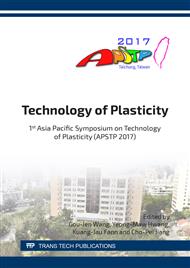p.58
p.64
p.70
p.77
p.83
p.89
p.95
p.102
p.108
Influence of Laser Shot Peening Parameters on the Surface Hardness and Roughness of 7075 Aluminum Alloy
Abstract:
The laser shot peening has the widely application prospect in aircraft structural parts repairment. The influence of laser shot peening parameters on the surface hardness and surface roughness has guiding significance for laser shot peening process. The variation law of surface hardness and surface roughness in the peening area of 7075 aluminum alloy were obtained based on the experiment research. The results show that the surface hardness improves effectively after laser shot peening, and the maximum hardness is 205.4HV, which is improved by 19.49% compared with the original hardness. Besides, the surface roughness of the rough specimen decreases; whereas, those of the smooth specimen increases after laser shot peening. However, both the surface hardness and surface roughness tend to be saturated when the impact times exceeds 3 times or the overlap rate exceeds 50%. Therefore, a good repairment effect can be obtained with 3 impact times and 50% overlap rate for the 7075 aluminum alloy specimen.
Info:
Periodical:
Pages:
83-88
Citation:
Online since:
April 2018
Authors:
Price:
Сopyright:
© 2018 Trans Tech Publications Ltd. All Rights Reserved
Share:
Citation:


